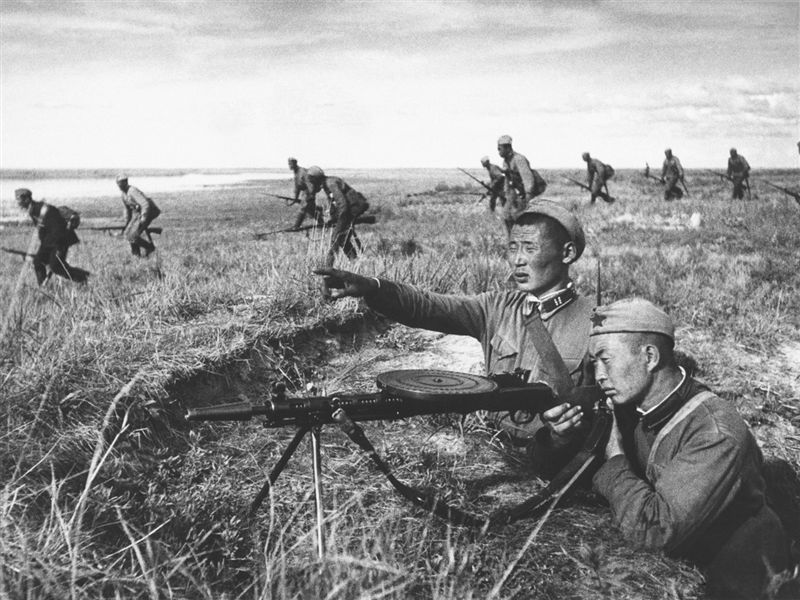Not many people know much about Mongolia today, much less what they did during WWII. Nestled between the Russia and China, it is completely different in language and culture although the Mongolian People's Republic has a current population of merely 3 million. This small nation played an indispensable role during the second world war to protect the Eastern front from the Japanese threat, while also mobilizing the Soviets against the Axis Powers.
During World War Two, Mongolia had very close tied to the Soviet Union, ruled under communism by Khorloogiin Choibalsan. At this time, with under 1 million peoples, was merely looked upon as a Chinese "breakaway province" or a Russian satellite. The nation provided the Soviet Union with money, food, clothing, livestock, and raw materials in their war against Germany. The relations between Russia and Mongolia were declared legally in 1934, when a "mutual assistance pact" was formed. If one nation needed help, military assistance would be provided. When there was no need for aid, the military would be removed. These agreements, were focused specifically on Japan, who had already come into Mongolia. Stalin was afraid of the Japanese threat, and conscripted around 10% of the entire Mongolian population. Pushing forward to 1939, during the Japanese invasion of China, the Soviets actually sent troops along the southern/southeastern border to protect them from the incoming Japanese. Commissar Vyacheslav Molotov had even stated, "we shall defend the frontiers of the Mongolian People's Republic as resolutely as our own border."
When the Japanese invaded Mongolia (outer) in 1939, they were defeated by the joint Soviet-Mongolian forces. There were around 10,000 soviet losses, while there were only 1130 Mongolian deaths. The Japanese lost over 18,000 men, and 25,000 were wounded. Why were the Japanese so promptly defeated? Much of this has to do with their overconfidence, but also superior Soviet Intelligence. A Neutrality Treaty between Russia and Japan was signed after this, which recognized Mongolia as neutral. The prominent battle(s) of Khalkhin Gol were fought at this time as well. Mongolia continued to support the Soviet Union, as the Mongolian Arat Squadron (a fighter squadron in the USSR Air Force) was created thanks to the financial contributions of the Mongolian People's Republic. Interestingly enough (although it was the 20th century) Mongolia also aided the Soviets with 500,000 trained military horses.
Mongolian support not only came from fighting, but also from their actual geographical location. In the "Soviet Far East Defense System", Mongolia was useful as a buffer zone. After the Japanese attacks, however, Khorloogiin Choibalsan continued to follow Moscow's orders. The Mongolian army remained "intact" throughout the war, even though it never became a part of the Red Army. It remained ready at numbers around 80,000 to guard its borders and prevent any possible Japanese attack. More specific goods that were given to the Soviets included "winter clothing, wool, hides, leather goods, meat, and almost half a million ponies and horses". Although the Mongolian indirect intervention in WWII did help the Soviet Union, it also acceleterated and bettered Mongolia as a nation. With continuously mobilized army, teachers became trained. Literacy increased, and the government was able to take a larger role in the life of an average nomad hersman. Obviously, quality of living also increased with more government intervention- and now the nation has a *bustling* 3 million(distributed over 604,00 sq.mi). Nomadic peoples played a huge role in the war effort, although the war did have a toll on their livestock numbers.
After the war, out of the 575,000 POWs that the Soviets had in their control, around 14,000 were sent to Mongolia for forced labor. Around 2000 died. In addition, Mongolia was recognized as an independent nation (by China), and the Mongolian people were granted total independence. Today, the Zaisan Memorial in Ulaanbaatar (the capital) serves as an important reminder to honor the Soviet and Mongolian troops who fought so hard in WWII. Not only a reminder of the lives lost, it also has images of friendship between the Soviets and Russia; a permanent landmark to commemorate their friendship.
1) Mongolian leader during WWII; Khorloogiin Choibalsan
2) Zaisan Memorial
3) Battle of Khalkhin Gol
4) Mongol Fighters



Sources:
http://factsanddetails.com/central-asia/Mongolia/sub8_2b/entry-4565.html
https://en.wikipedia.org/wiki/Mongolia_in_World_War_II
http://www.popflock.com/learn?s=Mongolian_Arat_squadron
https://ww2db.com/battle_spec.php?battle_id=89
https://en.wikipedia.org/wiki/Zaisan_Memorial
Anya -- I found your post very interesting because we often overlook Mongolia. While it is a country that is commonly known, as you mentioned, little is truly know about them as a nation. When Japan first occupied Manchuria, it made it apparent to the world the goal that Japan had of creating an Asia for the "supreme race": the Japanese. After that, Stalin declared that they would have to help the Mongolian People's Republic should Japan attack just as the Mongolians had helped the Soviets in 1921. Just the fact that the Mongolians were able to help the Soviets in the past and have formed a mutual friendship interests me because it shows how powerful both nations are and were. Despite this, we know more about Russia than Mongolia with Mongolia being less of an industrialized country compared to other major Asian super powers.
ReplyDeleteSources:
https://asiafoundation.org/2014/06/25/poverty-inequality-and-the-negative-effects-of-mongolias-economic-downturn/
http://factsanddetails.com/central-asia/Mongolia/sub8_2b/entry-4565.html